Search Result
Results for "
melanogenesis
" in MedChemExpress (MCE) Product Catalog:
2
Isotope-Labeled Compounds
| Cat. No. |
Product Name |
Target |
Research Areas |
Chemical Structure |
-
- HY-N0493
-
|
|
COX
Lipoxygenase
|
Inflammation/Immunology
|
|
Pectolinarigenin is a dual inhibitor of COX-2/5-LOX. Anti-inflammatory activity . Pectolinarigenin has potent inhibitory activities on melanogenesis .
|
-
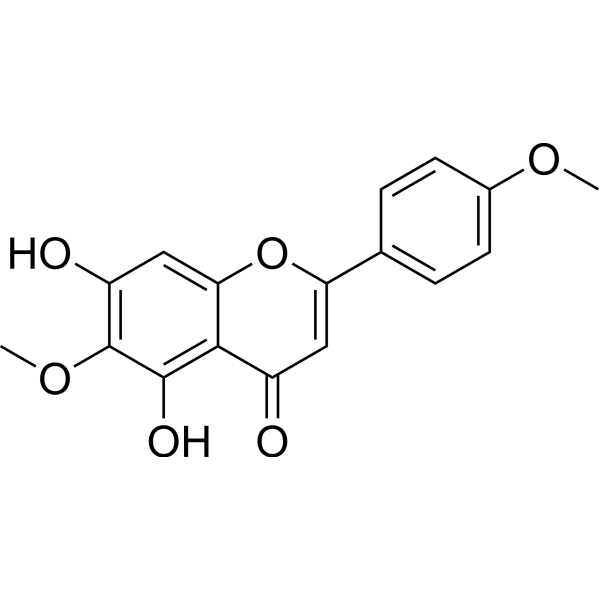
-
- HY-N2073
-
|
|
MCHR1 (GPR24)
|
Cardiovascular Disease
|
|
Ethyl linolenate is a fatty acid ethyl ester (FAEE). Ethyl linolenate plays an active role in inhibition of the cellular production on melanin with an IC50 of 70 μM. Anti-melanogenesis Effects .
|
-
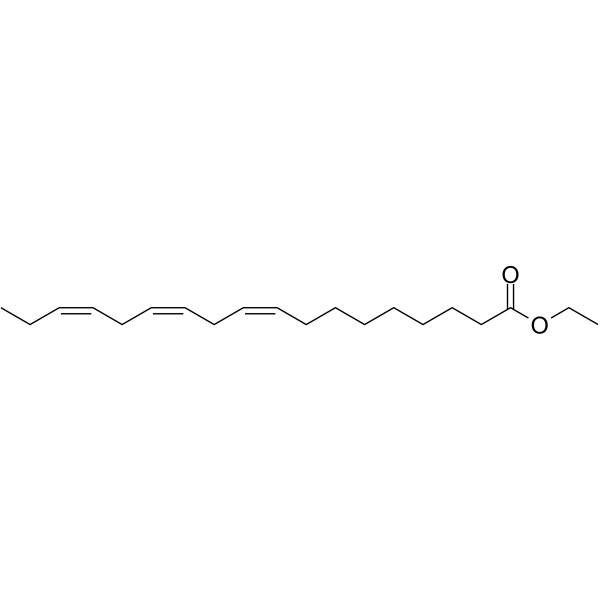
-
- HY-143459
-
|
|
Tyrosinase
|
Cancer
|
|
Tyrosinase-IN-5 (compound 16c) is a potent inhibitor of tyrosinase with an IC50 of 0.02 μM. Tyrosinase-IN-5 efficiently suppresses the melanogenesis without significant toxicity on cells .
|
-

-
- HY-N3643
-
|
|
Others
|
Cancer
|
|
Cryptomeridiol can be isolated from Phaulopsis imbricata. Cryptomeridiol has melanogenesis inhibitory activity in the α-MSH-stimulated B16 melanoma cells .
|
-
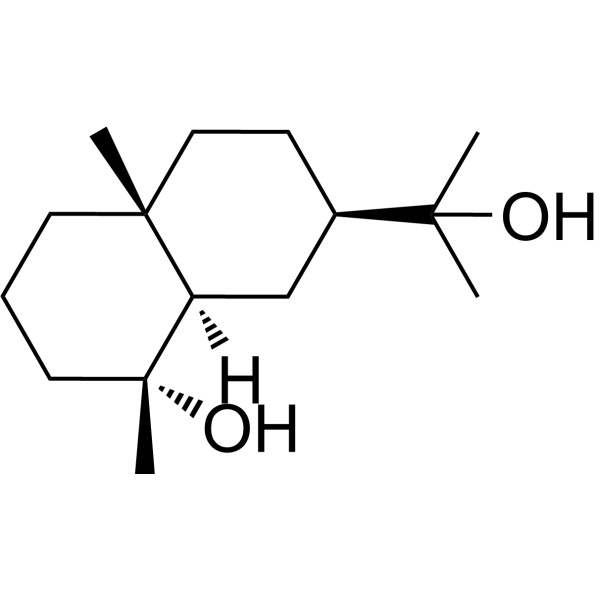
-
- HY-155189
-
|
|
Melanocortin Receptor
|
Others
|
|
IIIM-8 is a melanogenesis inhibitor. IIIM-8 inhibits pigment production both in vitro and in vivo without incurring any cytotoxicity in Human Adult Epidermal Melanocytes (HAEM). IIIM-8 can be used for hyperpigmentation disorders research .
|
-
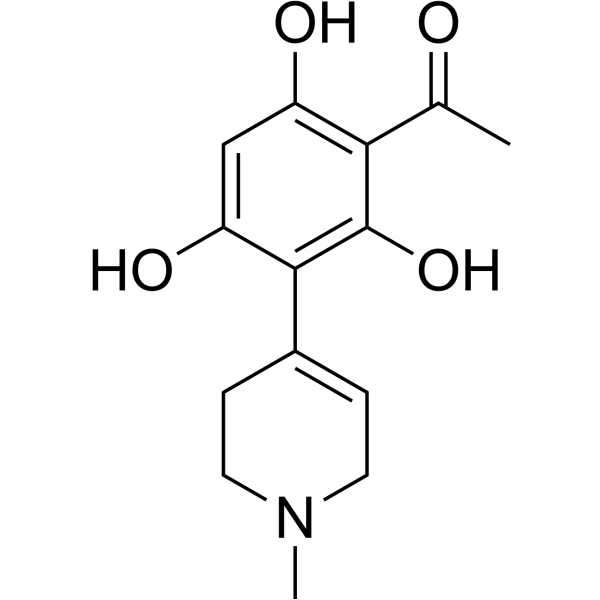
-
- HY-119808
-
-
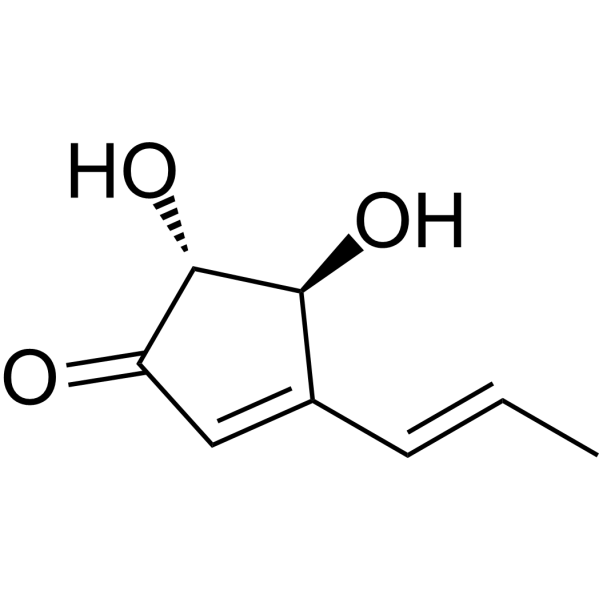
-
- HY-149698
-
|
|
Tyrosinase
|
Cancer
|
|
Tyrosinase-IN-17 (Compound 5b) is a lipophilic, skin-permeable, and non-cytotoxic Tyrosinase inhibitor (pIC50=4.99). Tyrosinase-IN-17 can be used for research on melanin-related diseases, such as melanoma, melanogenesis, etc .
|
-
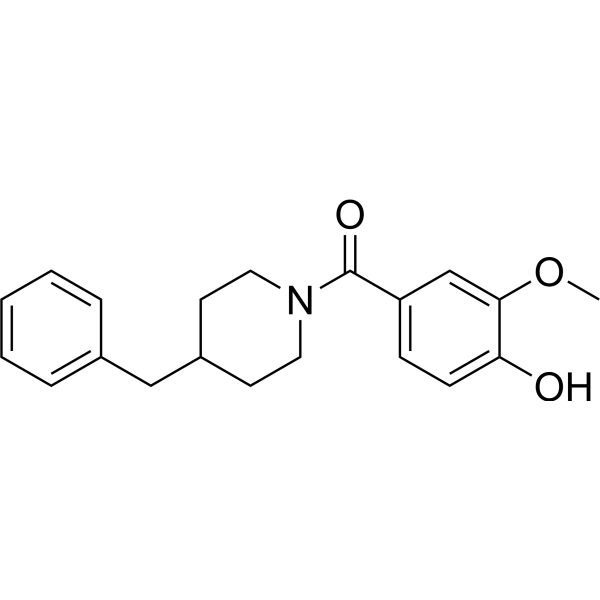
-
- HY-N0637A
-
|
(±)-Huazhongilexone; Dihydroluteolin
|
Melanocortin Receptor
|
Metabolic Disease
|
|
(±)-Eriodictyol ((±)-Huazhongilexone), a flavonoid, is a potent melanogenesis inhibitor with an IC50 of 48 μM. (±)-Eriodictyol suppresses tyrosinase, TRP-1, and TRP-2 mRNA expression. (±)-Eriodictyol has strong anti-plasmin activities .
|
-
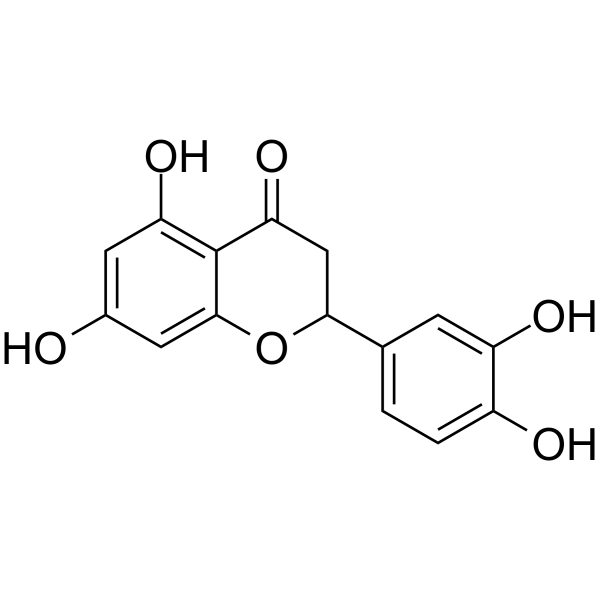
-
- HY-134046
-
|
Isodocarpin
|
Melanocortin Receptor
|
Metabolic Disease
|
|
(-)-Isodocarpin (Isodocarpin), a diterpenoid, is a potent melanogenesis inhibitor with an IC50 of 0.19 μM in B16 4A5 cells. (-)-Isodocarpin inhibits the expression of tyrosinase, tyrosine-related protein (TRP)-1, and TRP-2 mRNA .
|
-
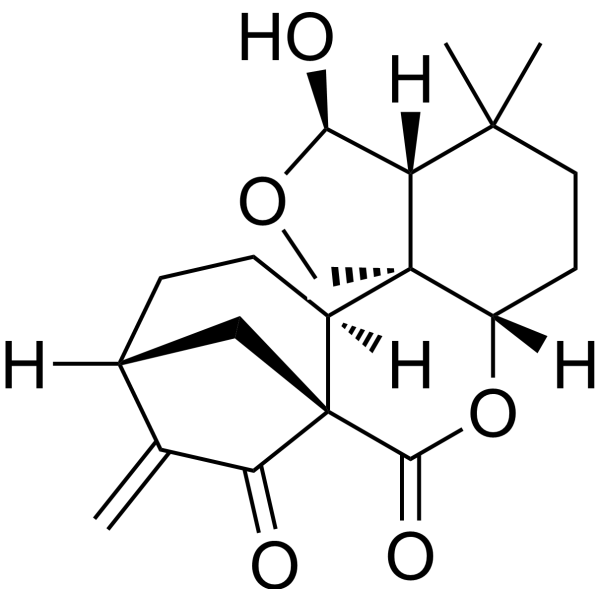
-
- HY-P4497
-
|
|
ERK
|
Cancer
|
|
Prolylserine, a dipeptide, is an inhibitor of melanogenesis production in Mel-Ab cells. Prolylserine decreases expression of microphthalmia-associated transcription factor (MITF) and tyrosinase, induces phorphosylation of ERK, but not cAMP response element binding protein (CREB) .
|
-
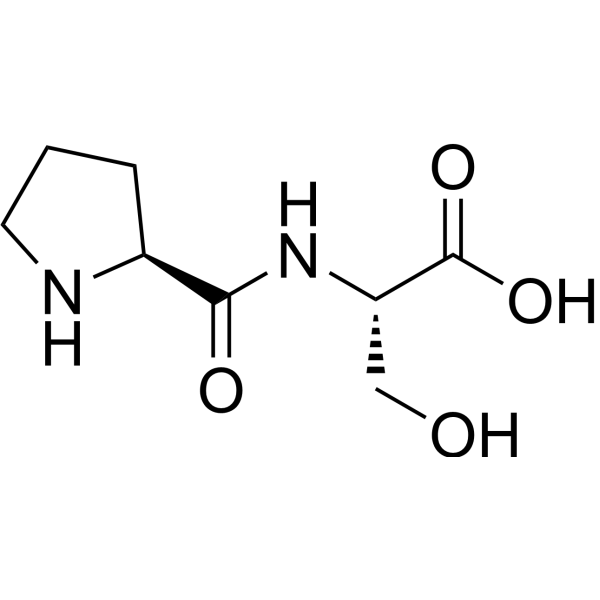
-
- HY-P0096
-
|
|
Tyrosinase
Sirtuin
|
Inflammation/Immunology
Endocrinology
|
|
Decapeptide-12, a small oligopeptide, is a tyrosinase inhibitor that interacts with C-terminal residue of tyrosinase (Kd: 61.1 μM). Decapeptide-12 is a competitive inhibitor of mushroom tyrosinase (IC50: 40 µM). Decapeptide-12 also increases transcription of SIRT. Decapeptide-12 reduces melanin content in melanocytes. Decapeptide-12 is used for the research of melanogenesis, senescence, inflammation .
|
-

-
- HY-N7717
-
|
(–)-(1R)-N-methylcoclaurine
|
Others
|
Metabolic Disease
|
|
(-)-N-methylcoclaurine possesses melanogenesis inhibitory activity .
|
-
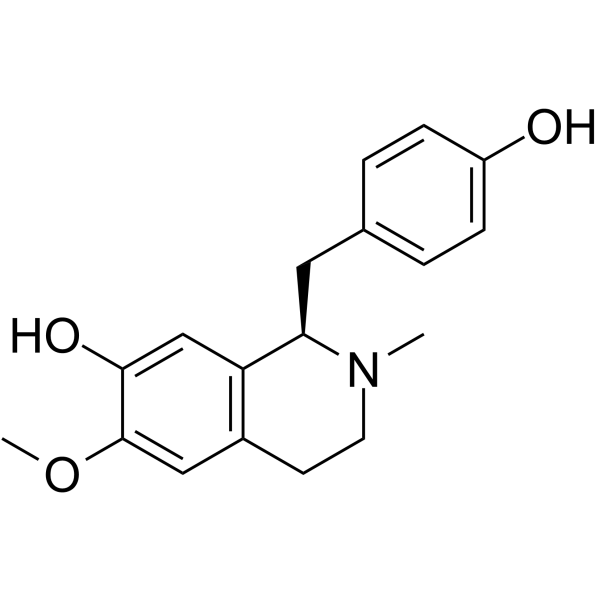
-
- HY-N0113
-
-
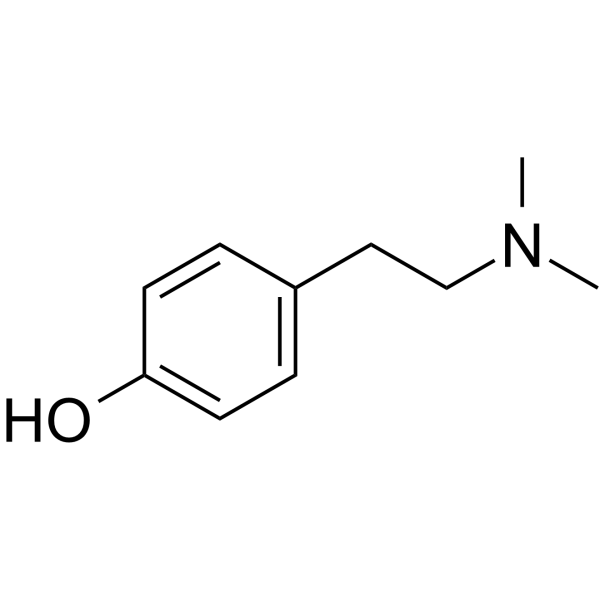
-
- HY-N3425
-
|
|
AMPK
|
Others
|
|
Kazinol U inhibits melanogenesis through the inhibition of tyrosinase-related proteins via AMPK activation .
|
-
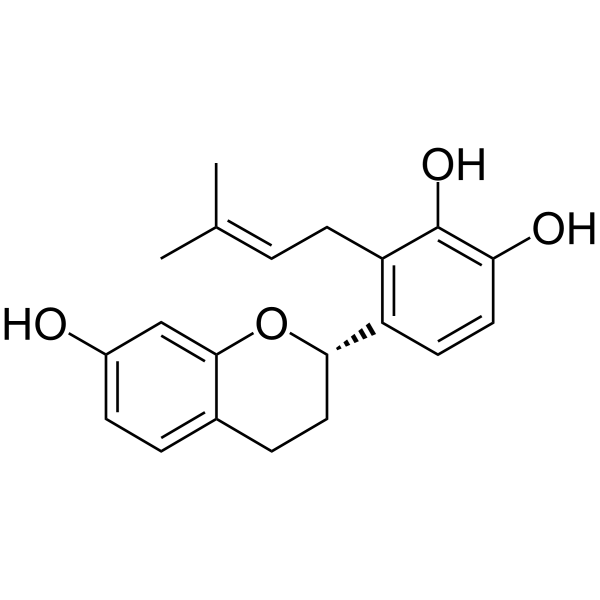
-
- HY-N0113B
-
|
Ordenina hydrochloride; Peyocactine hydrochloride
|
Antibiotic
|
Infection
|
|
Hordenine (hydrochloride), an alkaloid found in?plants, inhibits melanogenesis by suppression of cyclic adenosine monophosphate (cAMP) production .
|
-
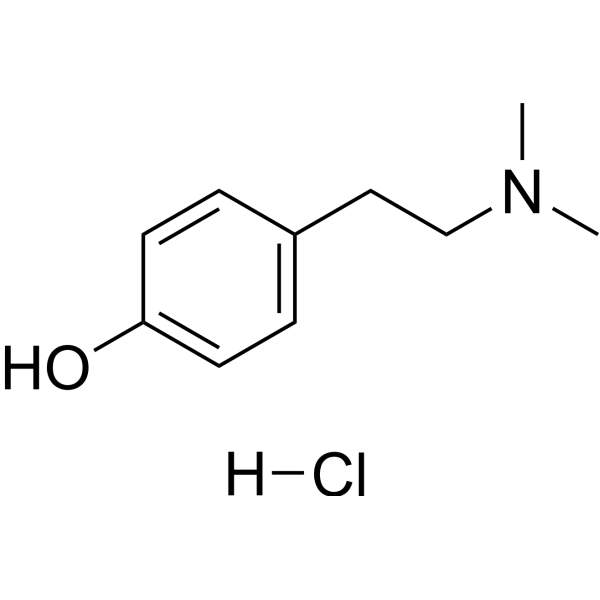
-
- HY-N5118
-
|
(-)-Chimonanthine
|
Tyrosinase
|
Cancer
|
|
Chimonanthine is an alkaloid of Chimonanthus praecox, inhibits tyrosinase and tyrosine-related protein-1 mRNA expression, amd inhibits melanogenesis .
|
-
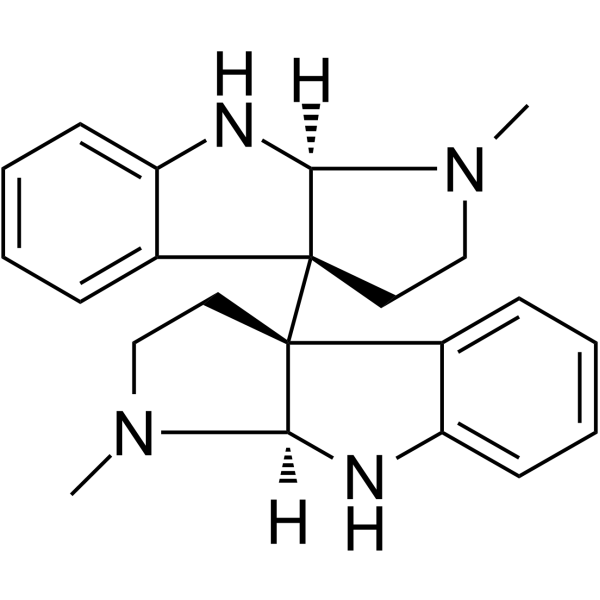
-
- HY-135743
-
|
cis-Apovincamine; (+)-Apovincamine
|
Others
|
Cancer
|
|
Apovincamine (cis-Apovincamine) is an indole alkaloid isolated from the Malaysian Alstonia pneumatophora (Apocynaceae). Apovincamine shows anti-melanogenesis activity .
|
-
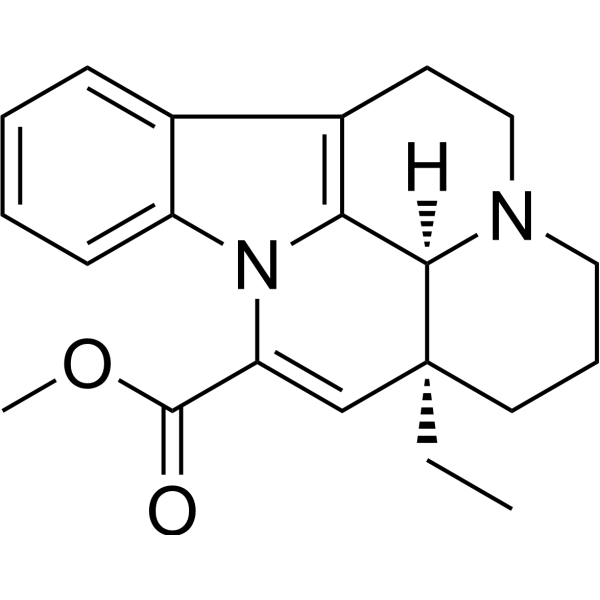
-
- HY-N3810
-
|
|
Tyrosinase
|
Others
|
|
ent-11α-Hydroxy-15-oxokaur-16-en-19-oic acid is an anti-melanin synthesis tyrosinase inhibitor, which can be isolated from Pteris fern. ent-11α-Hydroxy-15-oxokaur-16-en-19-oic acid regulates the melanogenesis transcription factor microphthalmia-associated transcription factor (MITF). The 11α-OH, 15-oxo and 16-en moieties of ent-11α-Hydroxy-15-oxokaur-16-en-19-oic acid are key fragments that inhibit melanin synthesis. The 19-COOH moiety has been implicated in the inhibition of cytotoxicity associated with 11α-OH KA and related compounds .
|
-
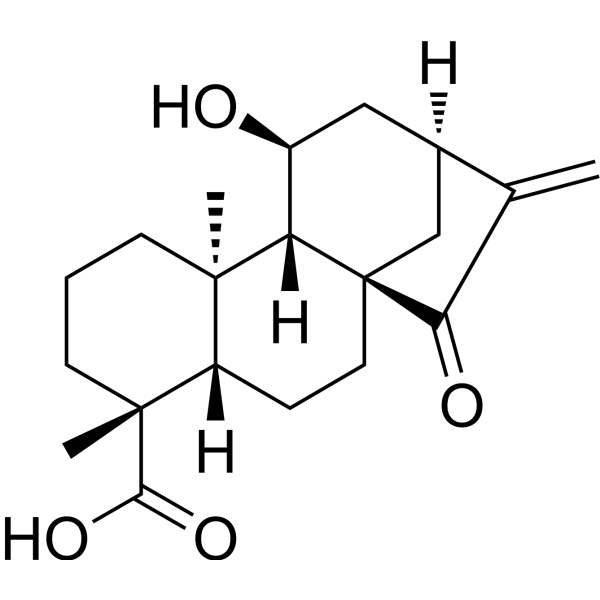
-
- HY-158021
-
|
|
Tyrosinase
|
Cancer
|
|
Tyrosinase-IN-26 (compound 13) is a uncompetitive tyrosinase inhibitor with the an IC50 value of 68.86 µM. Tyrosinase-IN-26 can suppresses melanogenesis .
|
-
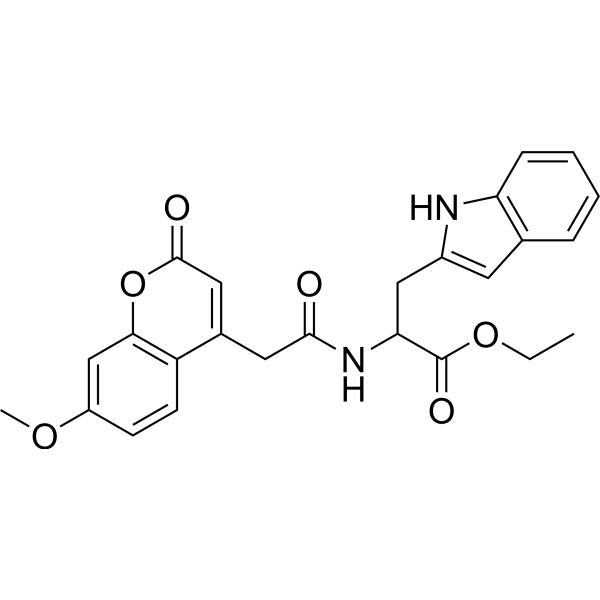
-
- HY-117761
-
|
|
PPAR
|
Metabolic Disease
Cancer
|
|
MHY908 is a potent dual agonist of PPARα and PPARγ . MHY908 also inhibits melanogenesis through inhibition of mushroom tyrosinase activity .
|
-
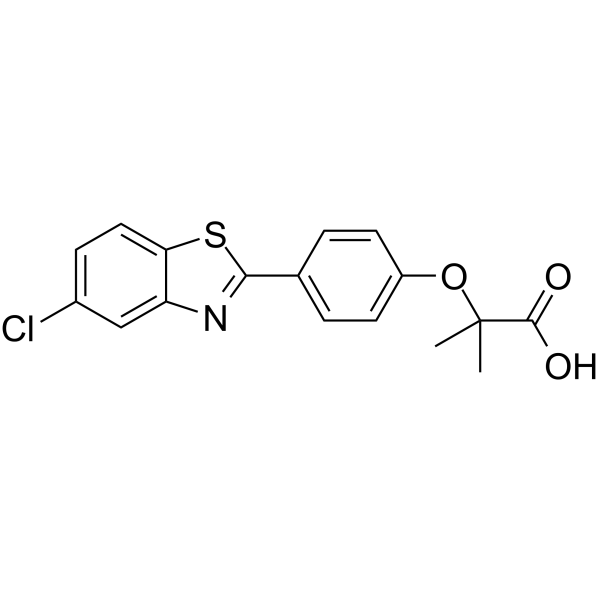
-
- HY-N0113R
-
|
Ordenina (Standard); Peyocactine (Standard)
|
Bacterial
Antibiotic
|
Infection
Cardiovascular Disease
|
|
Hordenine (Standard) is the analytical standard of Hordenine. This product is intended for research and analytical applications. Hordenine, an alkaloid found in plants, inhibits melanogenesis by suppression of cyclic adenosine monophosphate (cAMP) production .
|
-
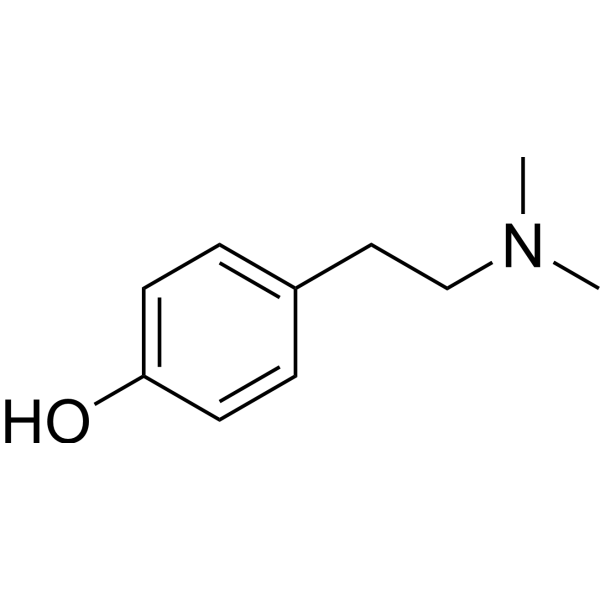
-
- HY-N6069
-
|
|
Others
|
Inflammation/Immunology
|
|
Raspberry ketone glucoside is a natural product in raspberry fruit. Raspberry ketone glucosidev has the inhibitory effect on the melanin synthesis .
|
-
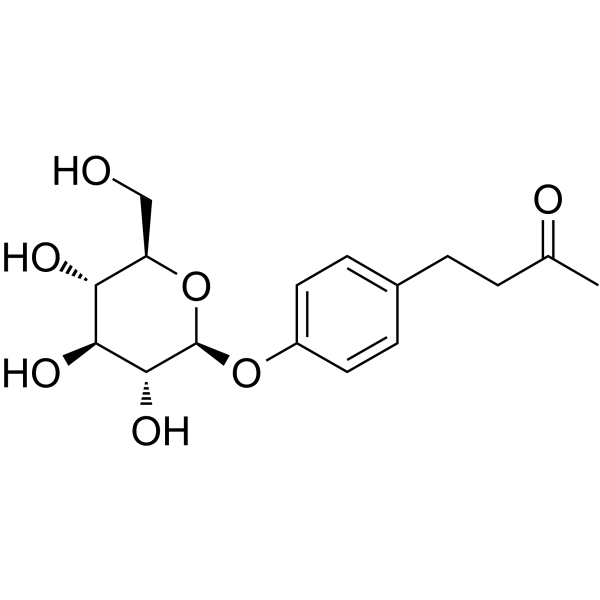
-
- HY-152194
-
|
|
Tyrosinase
|
Cancer
|
|
Tyrosinase-IN-10 (Compound 23) is a partially competitive tyrosinase inhibitor with an IC50 of 1.6 μM against tyrosinase activity from human melanoma cell lysates .
|
-
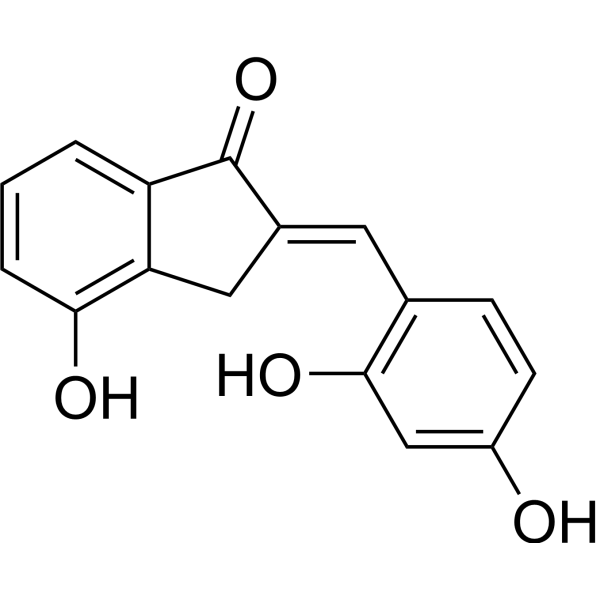
-
- HY-N0113S
-
-
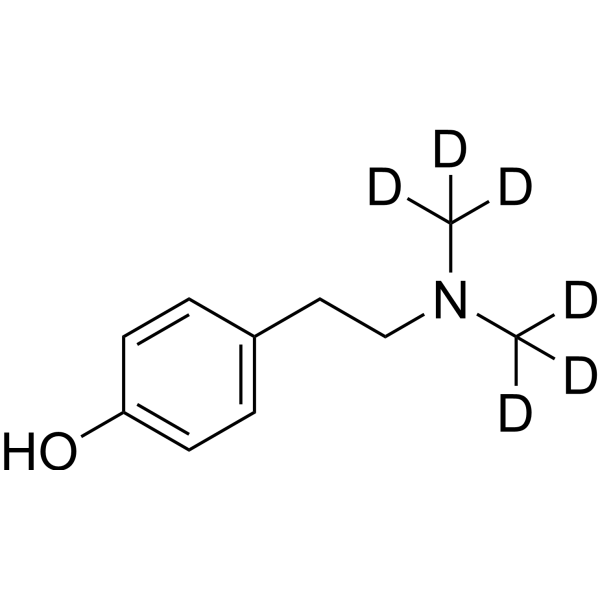
-
- HY-P5247
-
-

-
- HY-P5247A
-
-
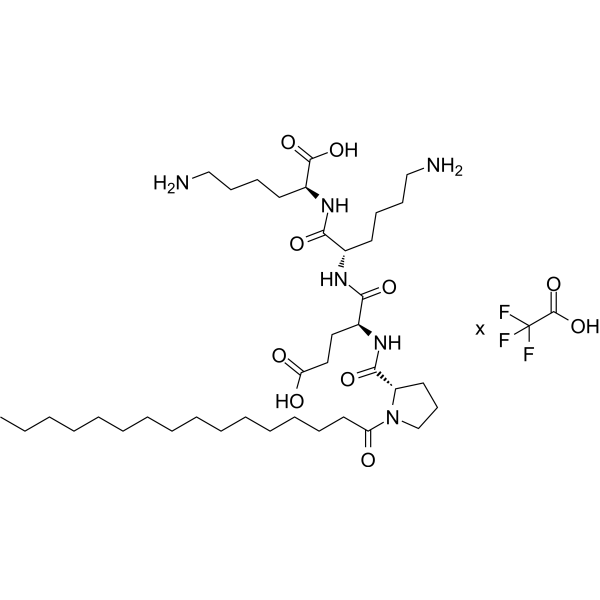
-
- HY-135014
-
|
|
Melanocortin Receptor
Adrenergic Receptor
|
Others
|
|
Undecylenoyl phenylalanine is an antagonist for α-melanocyte-stimulating hormone (MSH) and β-adrenergic receptor (β-ADR) to reduce the melanogenesis in melanocytes, reduces hyperpigmentation and thus ameliorates melasma lesions and solar lentigines .
|
-

-
- HY-N11521
-
|
|
Tyrosinase
|
Cancer
|
|
7-Methoxy obtusifolin (Compound 4) is a competitive tyrosinase inhibitor with an IC50 of 7.0 μM .
|
-
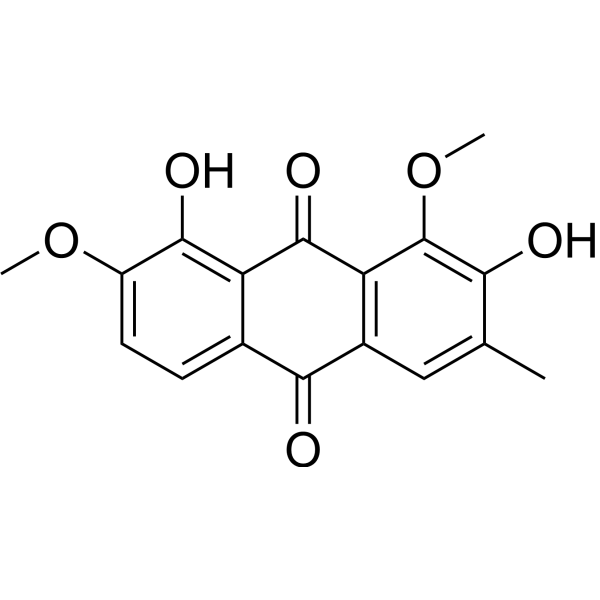
-
- HY-21268
-
|
Linolenic acid methyl ester
|
Others
|
Metabolic Disease
|
|
Methyl linolenate is a polyunsaturated fattly acid (PUFA). Methyl linolenate has an anti-melanogenesis activity with an IC50 of 60 μM. Methyl linolenate can also be used for studies of the mechanisms and prevention of oxidation/peroxidation of unsaturated fatty acids .
|
-
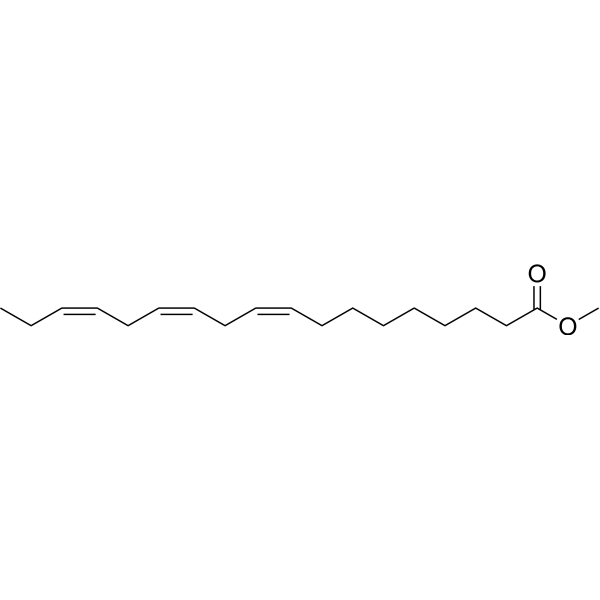
-
- HY-N2073S
-
|
|
MCHR1 (GPR24)
|
Cardiovascular Disease
|
|
Ethyl linolenate-d5 is the deuterium labeled Ethyl linolenate. Ethyl linolenate is a fatty acid ethyl ester (FAEE). Ethyl linolenate plays an active role in inhibition of the cellular production on melanin with an IC50 of 70 μM. Anti-melanogenesis Effects[1].
|
-
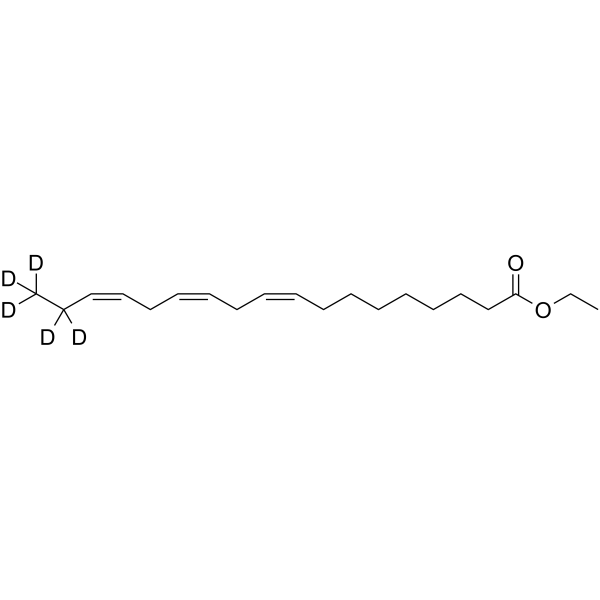
-
- HY-N10016
-
|
|
Tyrosinase
|
Cancer
|
|
Chlorogenic acid butyl ester, a caffeoylquinic acid, is a potent melanogenesis inhibitor. Chlorogenic acid butyl ester inhibits the expression of microphtalmia-associated transcription factor (MITF), tyrosinase, tyrosinerelated protein 1 (TRP-1), and TRP-2. Chlorogenic acid butyl ester also shows antioxidant activity .
|
-
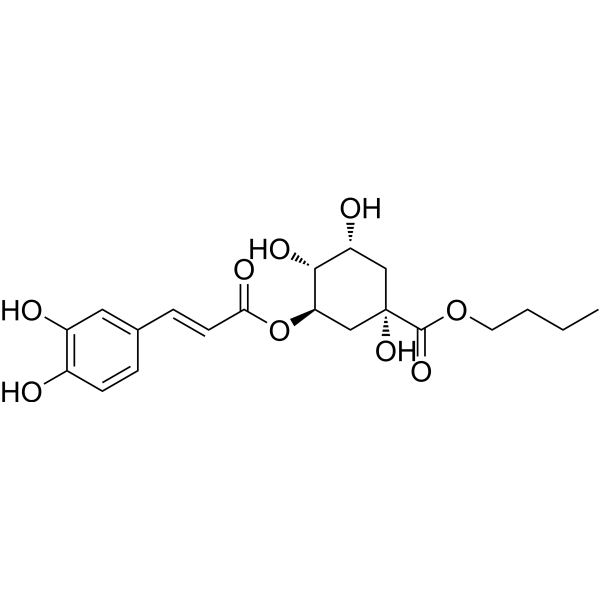
-
- HY-N1873
-
|
DMPB
|
|
|
|
(E)-4-(3,4-Dimethoxyphenyl)but-3-en-1-ol (DMPB) is a natural product that can be isolated from Zingiber cassumunar. (E)-4-(3,4-Dimethoxyphenyl)but-3-en-1-ol can increas melanogenesis .
|
-
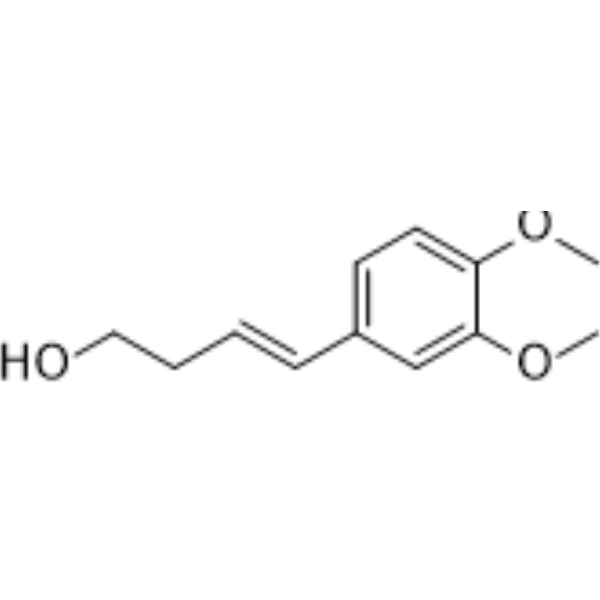
-
- HY-N2996
-
|
|
HIV Protease
|
Infection
|
|
Ganodermanondiol is a melanogenesis inhibitor isolated from the Ganoderma lucidum .Ganodermanondiol exhibits potent cytoprotective effects on tert-butyl hydroperoxide-induced hepatotoxicity . Ganodermanondiol shows significant anti-HIV-1 protease activity with an IC50 of 90 μM . Ganodermanondiol exhibits a strong anticomplement activity against the classical pathway of the complement system with an IC50 of 41.7μM .
|
-
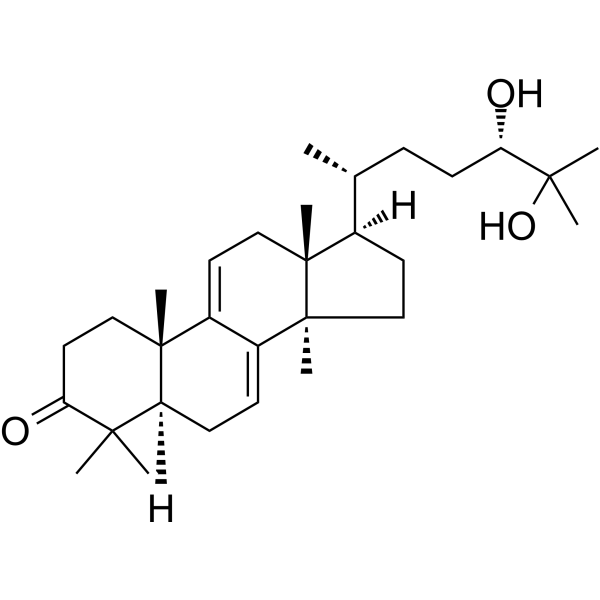
-
- HY-N2466A
-
|
MT-I acetate; [Nle4,D-Phe7]-α-MSH acetate
|
Melanocortin Receptor
|
Cancer
|
|
Melanotan I acetate is a potent non-selective melanocortin receptor (MCR) agonist. Melanotan I acetate is a synthetic analogue of α-melanocyte stimulating hormone (α-MSH) that stimulates melanogenesis. Melanotan I acetate can induce skin tanning by mimicking the actions of a-MSH on the melanocortin type 1 receptors (MC1R) of melanocytes. Melanotan I acetate can be used for sunlight-induced skin cancers research .
|
-
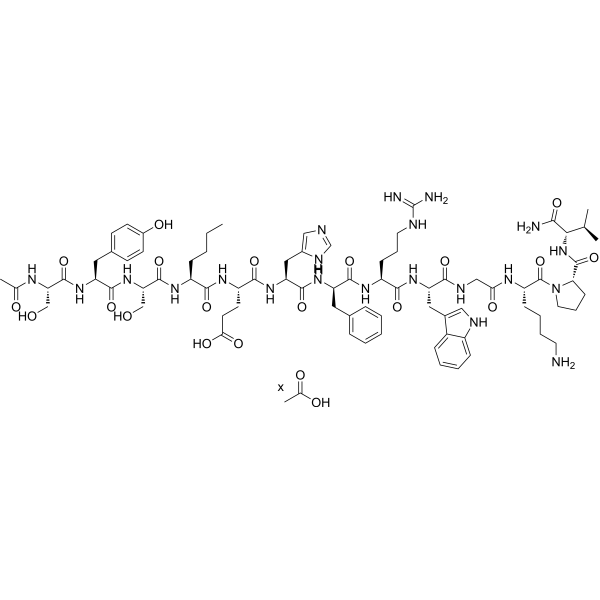
-
- HY-N2466
-
|
MT-I; [Nle4,D-Phe7]-α-MSH
|
Melanocortin Receptor
|
Neurological Disease
Cancer
|
|
Melanotan I is a potent non-selective melanocortin receptor (MCR) agonist. Melanotan I is a synthetic analogue of α-melanocyte stimulating hormone (α-MSH) that stimulates melanogenesis. Melanotan I can induce skin tanning by mimicking the actions of a-MSH on the melanocortin type 1 receptors (MC1R) of melanocytes. Melanotan I can be used for the research of sun-induced skin cancer, melanoma, inflammation and male erectile dysfunction .
|
-

-
- HY-N10802
-
|
|
ERK
Akt
PI3K
Epigenetic Reader Domain
|
Cancer
|
|
6-O-Isobutyrylbritannilactone is a natural melanogenesis inhibitor. 6-O-Isobutyrylbritannilactone, a sesquiterpene, can be isolated from the flowers of Inula britannica. 6-O-Isobutyrylbritannilactone inhibits IBMX (HY-12318)-induced melanin production in B16F10 cells. 6-O-Isobutyrylbritannilactone also regulates ERK, PI3K/AKT, and CREB, shows antimelanogenic activity in zebrafish embryos models .
|
-
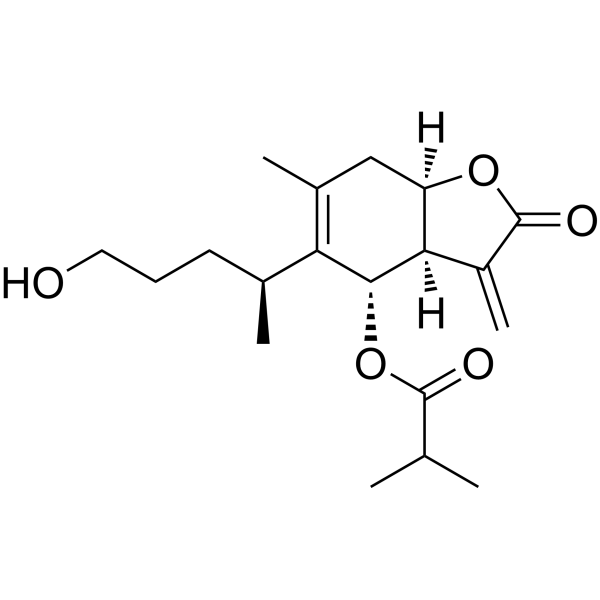
-
- HY-P0097A
-
|
Melanostatine-5 acetate salt
|
Melanocortin Receptor
|
Metabolic Disease
Endocrinology
Cancer
|
|
Nonapeptide-1 (Melanostatine-5) acetate salt, a peptide hormone, is a selective antagonist of MC1R (Ki: 40 nM). Nonapeptide-1 acetate salt is a competitive α-MSH antagonist that potently inhibits intracellular cAMP and melanosome dispersion induced by α-MSH in melanocytes (IC50: 2.5 nM and 11 nM, respectively). Nonapeptide-1 acetate salt inhibits melanin synthesis, and can be used in the research of skin pigmentation and regulation of steroid production in the adrenal gland, skin cancer .
|
-
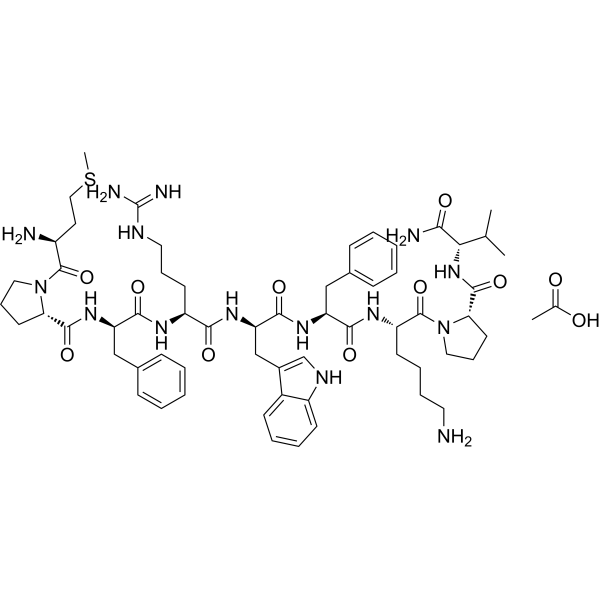
-
- HY-P0097
-
|
Melanostatine-5
|
Melanocortin Receptor
|
Metabolic Disease
Endocrinology
Cancer
|
|
Nonapeptide-1 (Melanostatine-5), a peptide hormone, is a selective antagonist of MC1R (Ki: 40 nM). Nonapeptide-1 is a competitive α-MSH antagonist that potently inhibits intracellular cAMP and melanosome dispersion induced by α-MSH in melanocytes (IC50: 2.5 nM and 11 nM, respectively). Nonapeptide-1 inhibits melanin synthesis, and can be used in the research of skin pigmentation and regulation of steroid production in the adrenal gland, skin cancer .
|
-
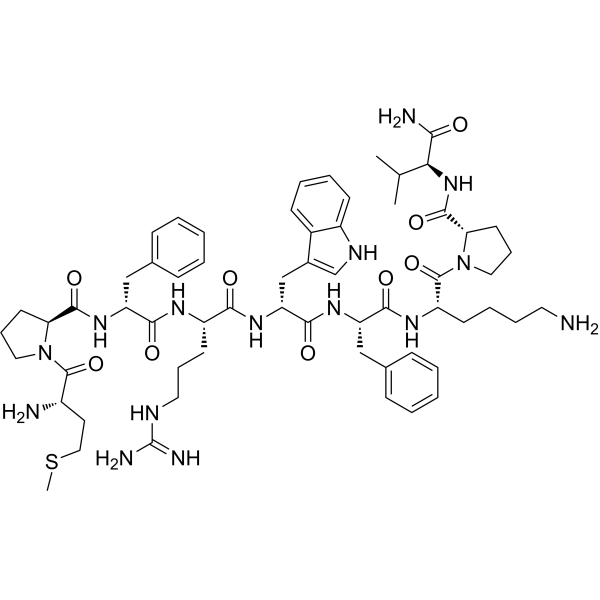
-
- HY-N0998
-
|
|
Others
|
Cancer
|
|
1,7-Bis(4-hydroxyphenyl)-hepta-4E,6E-dien-3-one (compound 6) shows antiproliferative activity with ED50s of 57.7, 78.8 µM for 26-L5 and HT-1080 cells, respectively. 1,7-Bis(4-hydroxyphenyl)-hepta-4E,6E-dien-3-one inhibits melanogenesis in B16 melanoma 4A5 cells. 1,7-Bis(4-hydroxyphenyl)-hepta-4E,6E-dien-3-one has the potential for the research of skin disorders .
|
-
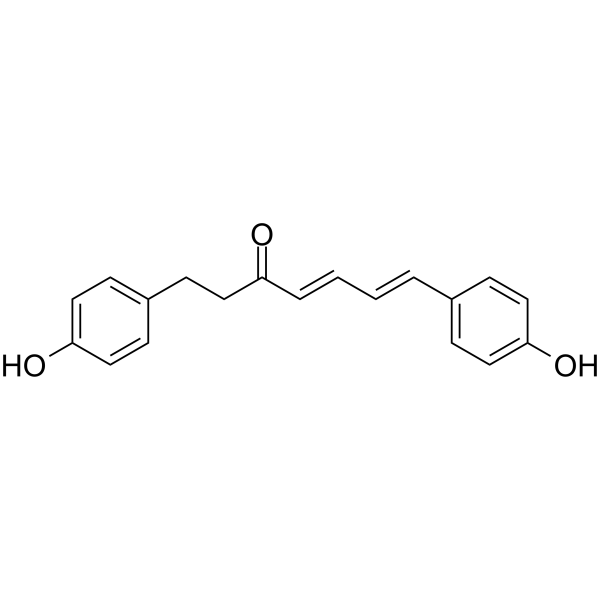
| Cat. No. |
Product Name |
Target |
Research Area |
-
- HY-P4497
-
|
|
ERK
|
Cancer
|
|
Prolylserine, a dipeptide, is an inhibitor of melanogenesis production in Mel-Ab cells. Prolylserine decreases expression of microphthalmia-associated transcription factor (MITF) and tyrosinase, induces phorphosylation of ERK, but not cAMP response element binding protein (CREB) .
|
-
- HY-P0096
-
|
|
Tyrosinase
Sirtuin
|
Inflammation/Immunology
Endocrinology
|
|
Decapeptide-12, a small oligopeptide, is a tyrosinase inhibitor that interacts with C-terminal residue of tyrosinase (Kd: 61.1 μM). Decapeptide-12 is a competitive inhibitor of mushroom tyrosinase (IC50: 40 µM). Decapeptide-12 also increases transcription of SIRT. Decapeptide-12 reduces melanin content in melanocytes. Decapeptide-12 is used for the research of melanogenesis, senescence, inflammation .
|
-
- HY-P5247
-
-
- HY-P5247A
-
-
- HY-P5264
-
-
- HY-N2466A
-
|
MT-I acetate; [Nle4,D-Phe7]-α-MSH acetate
|
Melanocortin Receptor
|
Cancer
|
|
Melanotan I acetate is a potent non-selective melanocortin receptor (MCR) agonist. Melanotan I acetate is a synthetic analogue of α-melanocyte stimulating hormone (α-MSH) that stimulates melanogenesis. Melanotan I acetate can induce skin tanning by mimicking the actions of a-MSH on the melanocortin type 1 receptors (MC1R) of melanocytes. Melanotan I acetate can be used for sunlight-induced skin cancers research .
|
-
- HY-N2466
-
|
MT-I; [Nle4,D-Phe7]-α-MSH
|
Melanocortin Receptor
|
Neurological Disease
Cancer
|
|
Melanotan I is a potent non-selective melanocortin receptor (MCR) agonist. Melanotan I is a synthetic analogue of α-melanocyte stimulating hormone (α-MSH) that stimulates melanogenesis. Melanotan I can induce skin tanning by mimicking the actions of a-MSH on the melanocortin type 1 receptors (MC1R) of melanocytes. Melanotan I can be used for the research of sun-induced skin cancer, melanoma, inflammation and male erectile dysfunction .
|
-
- HY-P0097A
-
|
Melanostatine-5 acetate salt
|
Melanocortin Receptor
|
Metabolic Disease
Endocrinology
Cancer
|
|
Nonapeptide-1 (Melanostatine-5) acetate salt, a peptide hormone, is a selective antagonist of MC1R (Ki: 40 nM). Nonapeptide-1 acetate salt is a competitive α-MSH antagonist that potently inhibits intracellular cAMP and melanosome dispersion induced by α-MSH in melanocytes (IC50: 2.5 nM and 11 nM, respectively). Nonapeptide-1 acetate salt inhibits melanin synthesis, and can be used in the research of skin pigmentation and regulation of steroid production in the adrenal gland, skin cancer .
|
-
- HY-P0097
-
|
Melanostatine-5
|
Melanocortin Receptor
|
Metabolic Disease
Endocrinology
Cancer
|
|
Nonapeptide-1 (Melanostatine-5), a peptide hormone, is a selective antagonist of MC1R (Ki: 40 nM). Nonapeptide-1 is a competitive α-MSH antagonist that potently inhibits intracellular cAMP and melanosome dispersion induced by α-MSH in melanocytes (IC50: 2.5 nM and 11 nM, respectively). Nonapeptide-1 inhibits melanin synthesis, and can be used in the research of skin pigmentation and regulation of steroid production in the adrenal gland, skin cancer .
|
| Cat. No. |
Product Name |
Category |
Target |
Chemical Structure |
| Cat. No. |
Product Name |
Chemical Structure |
-
- HY-N0113S
-
|
|
|
Hordenine-d6 (Ordenina-d6) is the deuterium labeled Hordenine. Hordenine, an alkaloid found in plants, inhibits melanogenesis by suppression of cyclic adenosine monophosphate (cAMP) production .
|
-

-
- HY-N2073S
-
|
|
|
Ethyl linolenate-d5 is the deuterium labeled Ethyl linolenate. Ethyl linolenate is a fatty acid ethyl ester (FAEE). Ethyl linolenate plays an active role in inhibition of the cellular production on melanin with an IC50 of 70 μM. Anti-melanogenesis Effects[1].
|
-

Your information is safe with us. * Required Fields.
Inquiry Information
- Product Name:
- Cat. No.:
- Quantity:
- MCE Japan Authorized Agent:















































